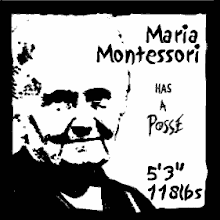the lesson plan from 1912
Becoming a Montessori teacher means learning the minutiae of the lessons described in the writing of Maria Montessori. It means reading Dr. Montessori's flowery prose about her ingenious cylinders and rods and beads and distilling her poetic conceptions into a numbered procedure for a very generic lesson plan.
This process is tedious, but so incredibly necessary. It elevates the lesson into a scientific operation, but at the same time becomes the artist's script. The lesson plan exists as the notes the artist inspects before the first brush stroke, the script the actor consults before summoning her emotion.
The lesson plan is something meticulous. It breaks down what to say and when to say it, it may well be the first "scripted curriculum". However, the effectiveness comes from the fact that the "script" of actions and words lasts for five minutes or less. It is a scripted, ordered moment in a day that flows loosely. The lesson has demanded the concentration of the teacher prior to the moment. Yet, it is a lesson that can be completed again and again, at a different time with a different child. It doesn't get stale like the instructions for gluing together the latest thematic art project.
Obtaining someone else's interpretation of an exercise is quite easy. Typing your own interpretation and working your hand out during class time to transcribe the details of your intsructors work is not so easy. But definitely time consuming. And that is the idea folks. That's why future doctors have to memorize 5,000 things every year in med school. I'm sure there's a psych study out there that proves that the memorizing and transcribing of info may be tedious work but it gets the brain to a saturation point, where you just start always thinking about things in terms of three period lesson or blood type or civil tort or whatever.
I'd keep going, but I have some sensorial excercises to transcribe. Woo.
Labels: montessori philosophy


0 comments:
Post a Comment
<< Home